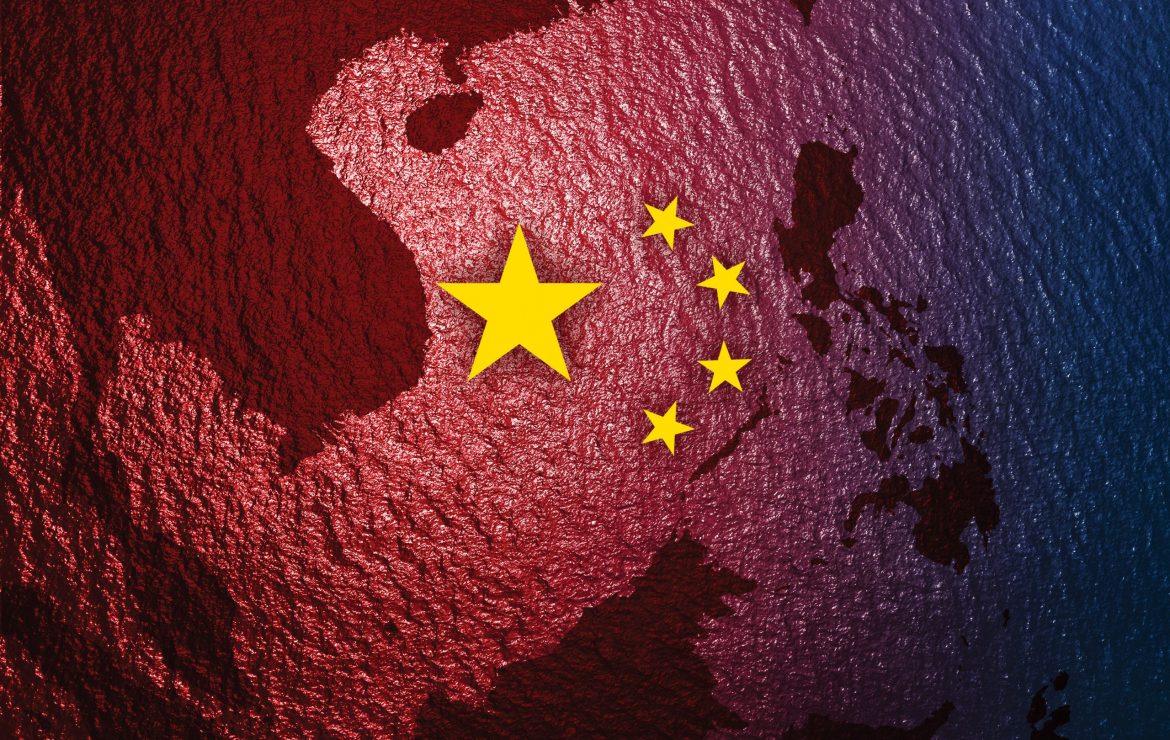China’s strategic interests in the Asia-Pacific maritime zone have inevitably brought it into conflict with neighbouring states ever since the declaration of the People’s Republic of China (PRC) in 1949. The early years after the end of the Second World War drew the battle lines in the East, when the US signed collective defence treaties with the Philippines (in 1951) and with Japan (in 1960) with the objective of stemming the tide of Communism. A stand-off over the status of Taiwan as an independent state has also been a source of simmering tension.
The 1990s saw a number of developments that changed the calculus, and by the beginning of the twentieth century, more direct confrontations with the US and its regional allies showed that a strategy of developing a blue-water navy with power projection over the whole region were becoming central to Chinese military planning. Onlookers now perceive the situation as part of a conscious new strategy of “hybrid” or “gray” operations, in which China incrementally achieves strategic gains while dropping just short of all-out war with the US and its allies. The perceived shift in Chinese military strategy was described in the title of an influential new volume by the US Navy’s China Maritime Studies Institute in the US in 2019, entitled “China’s Maritime Gray Zone Operations”.
The history
Despite developing as an organised, centralised state much earlier than other major powers to the West, China never showed much interest in developing a strong, deep-water navy. It was rather the European powers that eventually became big colonial powers in the late Middle Ages. When the Chinese communist state started realigning its economy to grow more effectively under the so-called Architect of Modern China, Deng Xiaoping, from 1978 onwards, traditional strategic thinking suggests China started to consider a more expansionist and forward-leaning military posture that would fit with its aspirations as a superpower eventually capable of challenging the Soviet Union or the US.
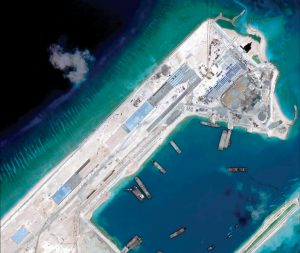
In the 1990s, following the collapse of the Soviet Union, two key factors shaped the situation. One was the discovery of new oil and gas deposits in the South China Sea. The second reflected the newfound confidence of the United Nations, marked in part by the coming into force of the UN Convention on the Law of the Sea (UNCLOS), implemented in 1994. Originally drawn up and agreed in 1982 amongst UN member states, including China, one of the key aims of UNCLOS is to provide a neutral arbitration mechanism over the management of natural resources in maritime zones.
The big question, about which UNCLOS arguably presents some ambiguity, concerns China’s infamous “nine dash line”. Originally mooted by a nationalist cartographer during the Chinese civil war in the 1940s, this line demarcates blue-water territory covering most of the South China sea beyond the immediate littoral margins of the regional states of the Philippines, Malaysia, Brunei, and Vietnam. China claims it has sovereignty over the mineral resources of this huge maritime region, and has increasingly made this point in the seas. Taiwan is also affected, exacerbating the threat of potential conflict over the island.
In the mid-1990s a crisis over Taiwan saw the US deploy the aircraft carriers, the Independence and Nimitz to the region, to signify its commitments to military allies. In 2009, Chinese naval frigates confronted the US ship, the Impeccable, when it sailed close to the Chinese island of Hainan. The same year marked the beginning of a more robust Chinese narrative about its claims to sovereignty over the waters of the South China and East China Seas, announcing a new “defensive” maritime strategy spearheaded by the People’s Armed Forces Maritime Militia (PAFMM). A number of incidents followed, including direct confrontations with Philippine, Vietnamese and Japanese vessels; the periodic conducting of provocative anti-ship missile tests; and the apparent annexation of uninhabited but disputed islands such as the Paracel and Spratly chains. On the latter, a major land reclamation project between 2013 and 2017 saw the construction of a significant new airstrip, providing Chinese military aircraft with an important footing in the region.
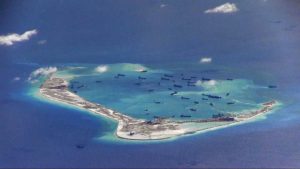
The Spratly Islands situation triggered a significant development, whereby the Philippines decided to take China formally to the UN tribunal under the provisions of UNCLOS. This process ruled against China in July 2016. The ruling covered a number of points, including a rejection of the principles of the “nine dash line”; and that the Spratly and neighbouring islands could not be subject to exclusive economic rights by any single state, as they are not technically fit for human habitation. Beijing apparently dismissed the ruling as “nothing more than a piece of waste paper”. It is also alleged by the Philippine president, Rodrigo Duterte, that Chinese premier Li Jinping personally threatened military action should the Philippines attempt to exploit gas reserves in an area known as the Reed Bank.
The concept of gray zone operations
Many commentators, including Erickson and Martinson, the editors of the recent US Naval Institute’s volume on China’s gray zone activities, see the changes in recent decades as evidence of a classic strategic shift in Beijing towards the core principles of “hybrid warfare”. It was, after all, the fifth-century Chinese military strategist, Sun Tzu, who wrote that the best way to achieve military victory is to avoid major conflict altogether.
Rather like the disputed “Gerasimov doctrine” allegedly deployed by Moscow in recent years, China’s recent maritime activities are seen as a creative strategy to conduct a low-level war of attrition in the South and East China seas, in which incremental gains are made without provoking the outbreak of open hostilities. The aim is sometimes described as “actions short of war”; or “war without gunsmoke”. In the contemporary environment, a range of strategies can be used to prosecute such a strategy, which have the benefit of negating the traditional firepower dominance of Western powers. These include the blurring of boundaries between military and civilian militias or other ambiguous actors; the use of psychological and media strategies to wage a battle of narratives; and the use of cyber capabilities, where a host of legal and definitional problems apply to the authorship of attacks and whether they constitute “acts of war”. Further dimensions can include “lawfare”, which means exploiting legal and regulatory ambiguities and complexities, and tying-up opponents in long and ultimately fruitless debates in the courts and UN agencies.
In the Chinese maritime context, Erickson and Martinson describe a strategy of using littoral coastguard and “paranaval” militia vessels such as those of the PAFMM to provoke confrontations, rather than using obvious grey-hulled naval frigates. In the information environment, it is suggested there is a mismatch between communications in Chinese-language sources – where, it is alleged, there is openness about Beijing’s strategy to adopt “administrative control” over all regional waters including those within the nine dash line – and those more widely distributed in English-language sources, where China is described as a responsible and “peaceful” member of the international community. Language such as “maritime rights protection” also creates a fog of uncertainty over the difference between defensive and offensive actions, much as was a tendency of the Soviet Union in the early days of the Cold War.
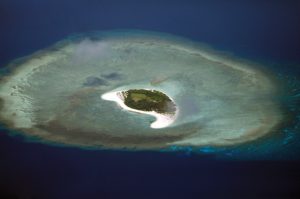
On the lawfare front, the allegations are that China is playing a complex double-game. On the one hand, it will see merit in presenting itself as a law-abiding and responsible member of the United Nations, complying with its obligations under UNCLOS and other international treaties to which it is a signatory. Its principle of non-interference in the sovereignty of other states is also repeatedly stressed. In a sense, an implicit challenge is offered to smaller and less well-defended states such as Vietnam and the Philippines to take on the regional behemoth of China in the courts, in the face of apparent military intimidation. At the same time, it is hoped that, such is the complexity and ambiguity of international law as it applies to maritime sovereignty, any legal challenges to its activities will generally take years to come to any sort of resolution. During this time, de facto gains can be made, which are then very difficult to reverse without escalatory military force.
The downsides of the “gray” strategy
Despite all of these supposed objectives on China’s part, there are potentially significant disadvantages to its strategy in the South and East China seas, which may ultimately limit the threat. While Beijing airily dismissed the findings against it in the UNCLOS tribunal in 2016, symbolic damage will have been done to its reputation as a peaceful and trustworthy member of the international community. On the one hand, there are signs that such rulings might allow China to dismiss the power of UNCLOS and embolden its resolution to go its own way. On the other hand, there is evidence that China has been quietly complying with the rulings to a certain extent, not least as it is difficult to do otherwise when it is a signatory to the treaty.
There is also an economic argument that China cannot afford to alienate regional states too much, as it has a reliance on them as customers for its products. A deep-seated animosity already exists with Japan, but if China pushes the likes of Vietnam, the Philippines and Malaysia too far into the US camp economically and politically, this could be damaging in the long term.
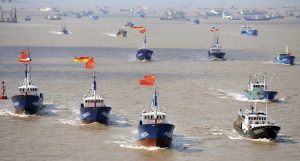
And one of the central problems with hybrid warfare is that it can backfire. Vietnam, in particular, has adopted a strategy of publicising transgressions against its vessels and making sure details find their way into the international press as much as possible. This can add to reputational damage suffered by China both regionally and internationally, and paint it as the bully in the playground. Such incidents highlight the mismatch between peaceful rhetoric and aggressive tactics.
Meanwhile, with a change of administration in Washington DC, it is not yet clear whether Biden will change the generally antagonistic stance adopted by Trump towards China and its strategic aspirations. The general feeling is that the message towards Beijing will not be softened particularly, but that pressure to find solutions around the negotiating table may be preferred over direct military confrontation.
» By : Julian Richards,
(University of Buckingham BUCSIS)


